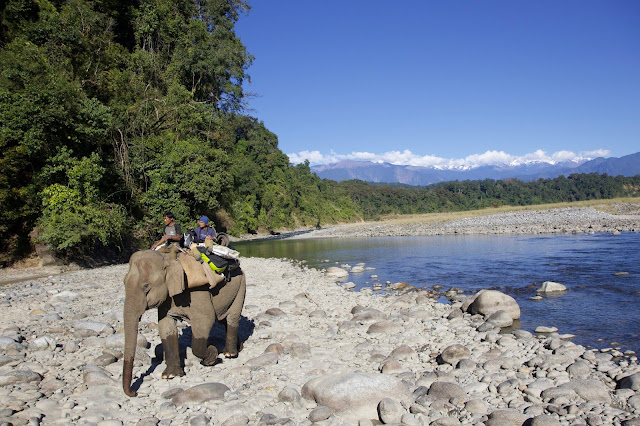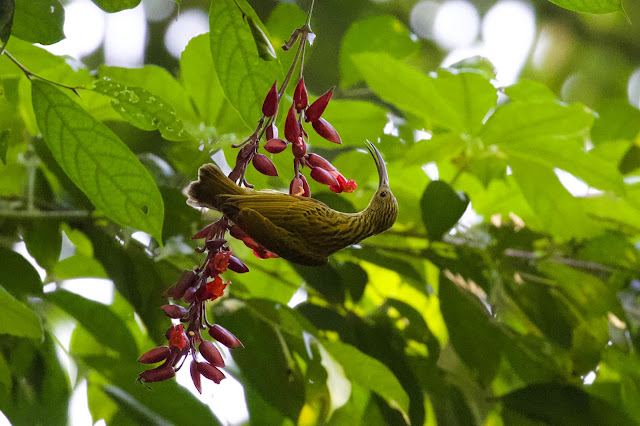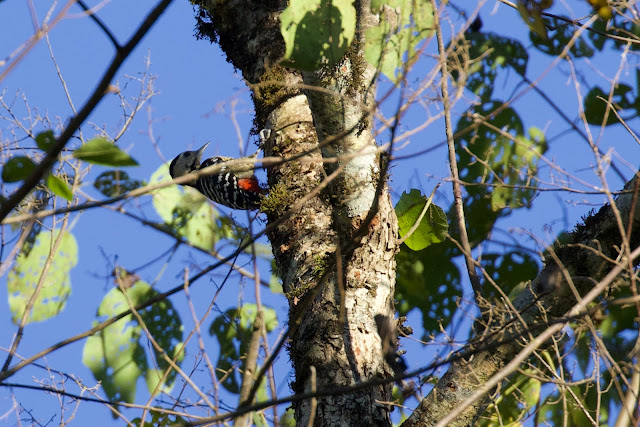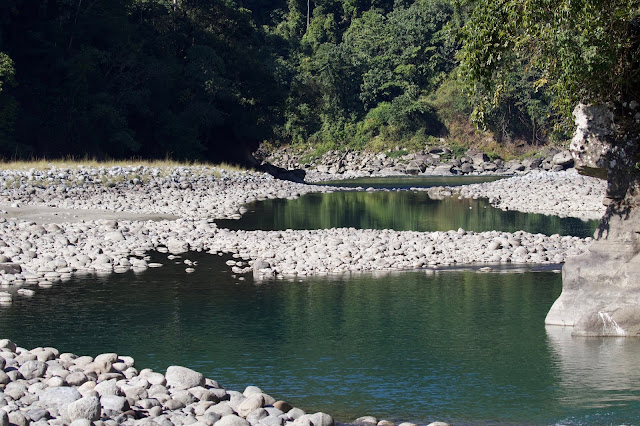Namdapha National Park - Pure Wilderness
Namdapha National Park
After the first visit, I knew that I had to return to explore more of Namdapha National Park. It is a rare place with amazing primary forests, hundreds of birds, and clean rivers. Very few tourists make it to Namdapha, mostly because it is not an easy place to get to and requires a special permit. There is one path through the forest and it takes one along a circuit of about 43.5 km and reaches a maximum elevation of 906m. We camped five nights walked six days and crossed the river 11 times. Our route is mapped below.Start from Dibrugarh
 Chickens for sale - fast food.
Chickens for sale - fast food.
This woman was cooking fish and it looked delicious.

We drove on to Miao. The park and distant mountains show up on a clear day in the background. The surrounding buckwheat fields were full of flowers from the previous month and were now waiting for the harvest.


 Pieces of the old bridge were being collected. They would try and rebuild it so people could cross the river.
Pieces of the old bridge were being collected. They would try and rebuild it so people could cross the river.

A rufous colored male above and a black female below. The red sack on their neck puffs out when they call.
Then on a side path, Dave and Nawraj found a stream emitting sulfide gas. They discovered that they could set it on fire.




A Streaked Spiderhunter hanging from a vine.
Red Whiskered Bulbuls.
Fulvous-breasted Woodpecker climbing up a tree.

Before starting, one night is needed in either Miao at Namdapha Jungle Resort or Deban at the forest guest house. We stayed in Miao and passed through Deban. We stopped for tea and to meet our porters at the forest guest house. We were happy to pass through. The guest house needs some repairs and a good cleaning.
A giant Malabar Squirrel was feeding on some leaves in the garden at the guest house. On my first trip, I stayed at Deban and I had seen a flying squirrel at night.
After heavy rains in mid-December, a flood removed the temporary bridge at Deban. It had been carried downstream and we had to cross by canoe.

 Pieces of the old bridge were being collected. They would try and rebuild it so people could cross the river.
Pieces of the old bridge were being collected. They would try and rebuild it so people could cross the river.
Our first hornbill sighting was high in the sky as Wreathed Hornbills flew above us at Hornbill camp.
We had a few good sightings the first day but it was late in the day when we got to Hornbill camp. After breakfast the next morning we started out to Firm Base.
The forest and birdlife are just amazing!
An Ashy Bulbul and a White-Throated Bulbul are in the photos below.

The forest and birdlife are just amazing!
An Ashy Bulbul and a White-Throated Bulbul are in the photos below.

We needed elephants for the five-day trek. All the bridges were taken out by the flood and it was the only safe way to cross the rivers in the park. Our two elephants take a rest and enjoy chomping down on the jungle trees, ferns, and vines - which they do all night long.
Meanwhile, the mahout has taken up bird watching. His name is Tarzan - really.
We had a prize early the first morning as we started for Firm-base camp - a pair of Rufous-necked Hornbills were calling. They are a globally threatened species. We had to push through the bushes and trees to try and get a better sighting. They were in the tip-top branches of a huge tree and difficult to see.
Our second prize of the day was Hoolock Gibbons calling or "hoolock-ing" back and forth between two groups - an amazing sound!

Our second day, December 23, was a long one. We walked about 13km taking 7 hours in all for photos and many other distractions. Pretty soon the elephants caught up at our lunch rest stop. Tarzan was looking very relaxed.
A rare sight was the White-hooded Babbler and below a commonly seen Bronzed Drongo.
Firm-base Camp is also a park ranger base. From there they try to monitor disturbances in the park and track big mammals like tigers and leopards. One tribal group, the Lisu, encroach into the core area of the park where they grow cardamon. Many Lisu came from across the border in Myanmar and settled in Arunachal. Culturally they have always been hunters and have a strong Christian faith.

The park has a look-out structure or machan in front of the camp over a small stream. It is a good place for bird watching. We had wonderful mountain views from there too.


A Streaked Spiderhunter hanging from a vine.
Red Whiskered Bulbuls.
Fulvous-breasted Woodpecker climbing up a tree.
Mountains!
Our prize on Christmas Eve was sighting a critically endangered White-bellied Heron. Only one of 6 found in the area with maybe only 30 left in this region. During the day we spotted 4 of these rare herons along the river.
At the same time, a Black-Necked Stork flew over. It was a morning for giant birds.


Our prize on Christmas Eve was sighting a critically endangered White-bellied Heron. Only one of 6 found in the area with maybe only 30 left in this region. During the day we spotted 4 of these rare herons along the river.
At the same time, a Black-Necked Stork flew over. It was a morning for giant birds.
We walked next to the river the whole day until at one point we had to cross. Now we needed the elephants.

We had to cross the river not just once but in three places. At one spot the elephants had to make a bridge. They followed commands and dropped large tree trunks at the spot where everyone had to cross.

We finally reached our campsite. There was a big swimming hole just at the bend in the river, but brr it was way too cold for me.


Our Christmas camp on the river with a sunset behind.
There was so much wood around we easily made a large fire to keep warm. We watched the sunset, drank warm rum, and then the full moon came up. It had been a lovely day and night.
Christmas morning! We gave everyone lopsi sweets and nuts from Nepal, which they gobbled up immediately. Tarzan was feeling cold and dressed in his hat and long sleeves for the first time. He is a bit of a loner and tends to set up a small shelter using elephant blankets instead of sleeping with the rest of the guys in a tent.
Another day by the river, more birds, more sun, and a beautiful day.
It was fantastic weather in December. In the center are our two guides Vicki, a private bird guide, and Tawang who works with the forestry department. They were always there to help us.
The mahouts, Ganesh above and Tarzan below were very kind to the elephants. They never hit them and made sure they were safe at night. Our cook staff enjoyed getting a ride too. We had a wonderful group of support people.




There was so much wood around we easily made a large fire to keep warm. We watched the sunset, drank warm rum, and then the full moon came up. It had been a lovely day and night.
Christmas morning! We gave everyone lopsi sweets and nuts from Nepal, which they gobbled up immediately. Tarzan was feeling cold and dressed in his hat and long sleeves for the first time. He is a bit of a loner and tends to set up a small shelter using elephant blankets instead of sleeping with the rest of the guys in a tent.
Another day by the river, more birds, more sun, and a beautiful day.
We brought our new tent and were really happy with it - it was easy to put up and take down. This was early Christmas morning with the fog drifting by.
Several eagles were flying by during the next day's walk. A Grey-headed Fish Eagle and a Crested Serpent Eagle.
The mahouts, Ganesh above and Tarzan below were very kind to the elephants. They never hit them and made sure they were safe at night. Our cook staff enjoyed getting a ride too. We had a wonderful group of support people.

An Ibisbill was surprised by us and flew off.

Two young Chakma porters were crossing the same rivers we crossed but they did it without the elephants. It was dangerous for them and the water was icy cold.


Looking for bugs on the rocks is a Slaty-backed Forktail.
A cormorant flying low. There were many groups of cormorants sitting on the river stones as we walked by.

A cormorant flying low. There were many groups of cormorants sitting on the river stones as we walked by.

I am not a huge fan of Macaque monkeys but the Assamese Macaques are rare and not pests like other races of Macaques.
A special bird - Golden-crested Myna on the bottom left with a chick upper right.


No doubt Poo Bear would climb this tree to get to the honeycombs, but here people collect wild honey going out on the horizontal branches high above the ground. If you look closely you can see the bamboo ladder attached to the trunk.

People were busy harvesting their buckwheat crops and cleaning the grains.
A Chakma woman walks through the small lane beside the buckwheat fields to go home at sunset.
It was the end of a fantastic trip and a wonderful Christmas holiday. We saw 104 bird species, three primates, 4 types of squirrels, butterflies, and dragonflies. A Bonelli's Eagle waves us on below. An amazing trip!
People were busy harvesting their buckwheat crops and cleaning the grains.
A Chakma woman walks through the small lane beside the buckwheat fields to go home at sunset.


















































Fantastic post Karen! It was wonderful reading through this to catch up on your adventures. There are more birds than Odonata in Namdapha it seems! All the best from your old home in Sri Lanka!
ReplyDeleteIan
https://ianlockwood.wordpress.com